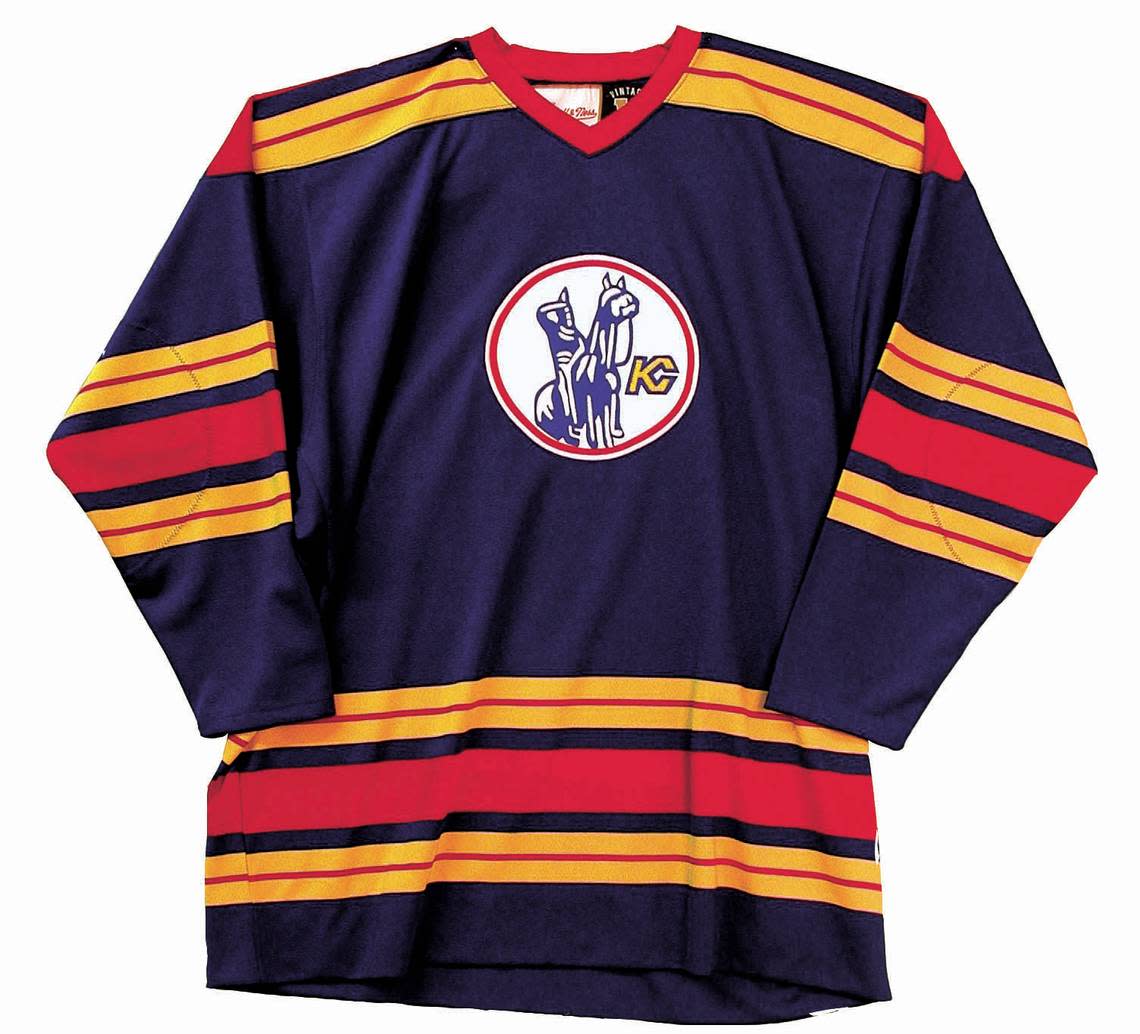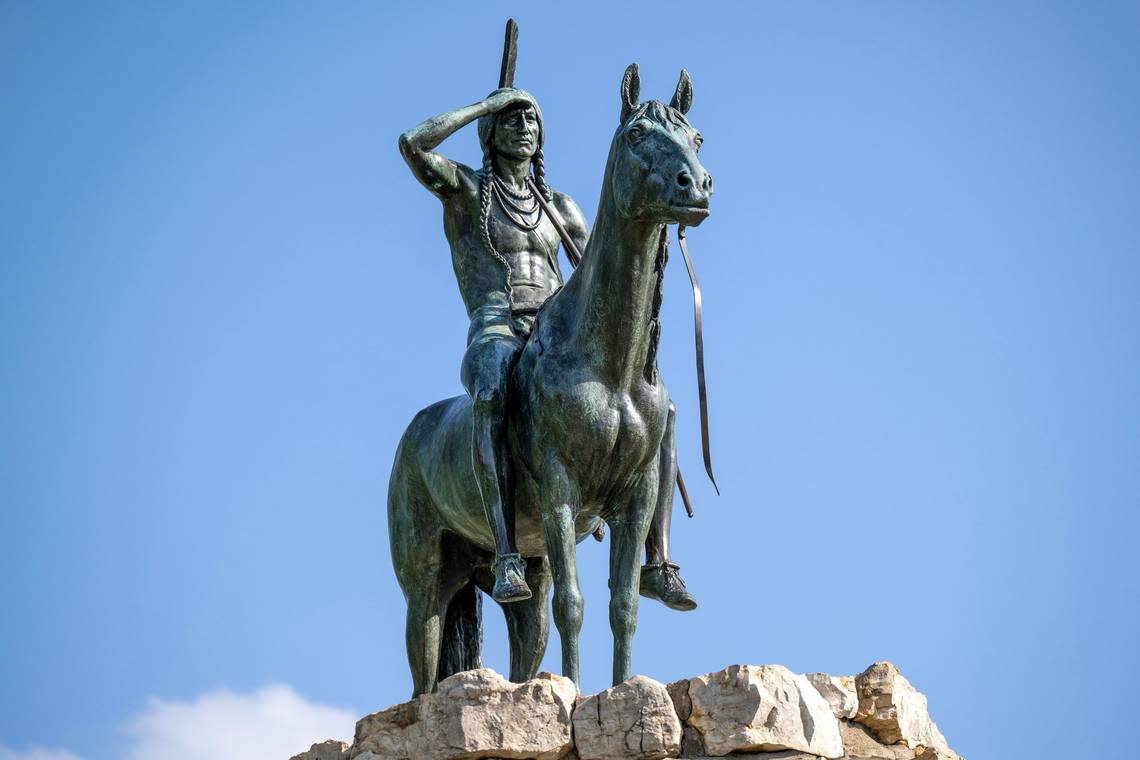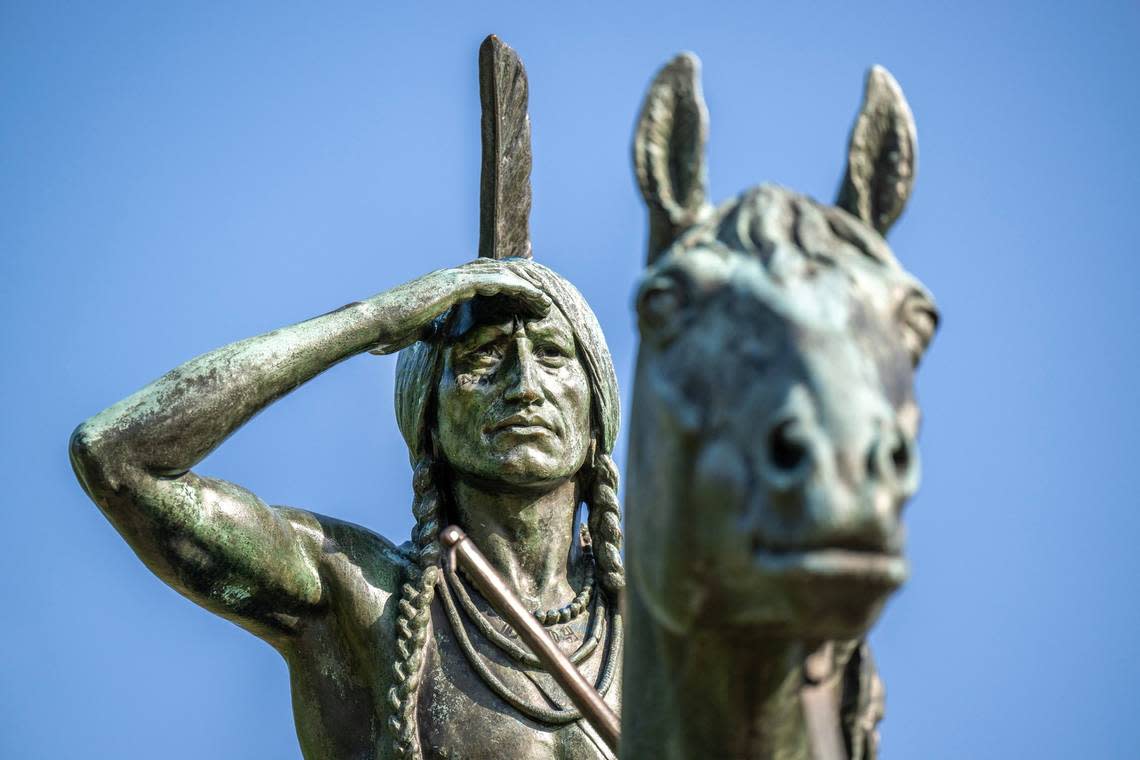The Chiefs offend some Native Americans. Here’s why this KC icon is a different story
Your Guide to KC: Star sports columnist Vahe Gregorian is changing uniforms this spring and summer, acting as a tour guide of sorts to some well-known and hidden gems of Kansas City. Send your ideas to vgregorian@kcstar.com.
Straddling his steed atop a bluff in Penn Valley Park, the majestic sculpture of The Scout has peered over Kansas City for over a century.
Preceding the Liberty Memorial or interstate highways and neon everywhere, before the Bartle Hall Sky Stations and the Kauffman Center for the Performing Arts and the KC Wheel, The Scout has been above it all, shading his eyes riveted toward the future unfurling below.
But the enduring icon looking over us seems easily overlooked.
To visit The Scout practically requires a modern scout’s orienteering skills. It’s remarkably accessible but entirely obscure.
You can catch a glimpse of it from the road, perched between Broadway and Southwest Trafficway. But if you want to get close, even a GPS only gets you so far turning in from 31st Street by the subtle sign at Penn Drive.
Drive by a skate park and basketball and tennis courts, and another apathetic marker suggests it’s vaguely ahead. Then walk between concrete barriers another 50 or so yards.
Presto, you’re engulfed in a captivating panorama that simultaneously compels you to ponder the past and wander to the future.
No one else was in sight one recent day at the scene, which remains absorbing despite graffiti on the pedestal (but not, at least on this day, on the statue itself) and litter.
On another day, several sets of people happened by. Among them was a man prospecting nearby with a metal detector and three young men from Wichita who so revere the view and the “foreshadowing” image that they come here every time they are in town.
Leaving the scene particularly open to interpretation is a curious omission.
Somewhat reflecting an artistic inclination to keep The Scout boundless and perhaps because of the vandalism around and on it since its inception, there is no plaque or marker explaining who created it: the renowned Cyrus E. Dallin, who grew up among Native Americans and became known as a fervent Indigenous rights advocate.
Nothing tells of the peculiarities that led to its permanent home being established here — including that it initially was Boston-bound after its debut at the 1915 Pan-Pacific Exposition in San Francisco and that we had to fend off a bid from The Smithsonian to keep it.
It’s all fascinating in itself, and we’ll get right back to that.
But first a little detour about why I wanted to explore The Scout.

‘It needs to be talked about’
Soon after we moved to Kansas City in 2013, I asked my wife, Cindy, for a Kansas City Scouts hockey sweater for Christmas.
The Scouts, you may or may not know, were a slapstick NHL team that debuted in 1974 and went 27-110-23 in two seasons before being sold and moved to Denver and later morphing into the New Jersey Devils.
Now, virtually every sportswriter avoids wearing, or even owning, the gear of teams they cover and goes into contortions to not display colors of either side when covering a game. It’s all in the interest of objectivity.
But I figured this was exempt since the Scouts were defunct, I thought the logo was cool and I’ve always loved hockey, perhaps the most exhilarating sport to see in person.
Plus, I thought of it as a nod to a dignified and defining city monument distinct from the controversial imagery of the Chiefs — who in recent years have made strides in discouraging tasteless costumery but still play music stoking the tomahawk chop.
(My moment of clarity on the gesture emerged on the way into a 2016 Chiefs game in Houston, where some Native Americans were protesting appropriation of their heritage. A fan in a Travis Kelce jersey, accompanied by a child, taunted them by directing the chop their way. It seemed a telling metaphor.)
After I wore the sweater a few times, though, I started asking myself if it was such a clear distinction. Less as a sportswriter than as a person.
For years now, it’s been up on a closet shelf I can’t reach without a ladder.
So while working on this “Uniquely KC” project for a few months, it occurred to me it might be a good time to try to reconcile the feeling by delving into The Scout’s history and seeking perspective at the Kansas City Indian Center.
Founded in 1971, the organization believes itself to be the nation’s oldest continuously operated center serving the American Indian community — befitting a region shaped by numerous tribes over thousands of years.
Its stance on the local NFL franchise is firm as a “proud member of the Not In Our Honor Coalition” calling for the team to change its name and, most of all, do away with attached cultural appropriation.
To the Indian Center, the very notion of The Scout being summoned as a mascot, even a half-century later, falls into an anguishing category: Mascoting reinforces stereotypes that are diminishing and dehumanizing and perpetuate multi-generational trauma.
But when it comes to the stature of this statue, executive director Gaylene Crouser and Bob Prue, a longtime board member and current director of the center’s Morningstar Outreach Program, are ambivalent.
Asked whether she considered it to be appropriation or appropriately honorary, Crouser said, “A little bit of both. … And so it’s a little bit hard to really explain how something can be both things to us.”
While Prue wonders about the intent and context of when The Scout was built and installed — several years before Native Americans were at long last “granted” citizenship 100 years ago next month — he finds nothing “patently offensive” about it.
“It seems as though it’s an Indigenous person who could be scouting for buffalo, could be scouting for enemies, could be scouting for water, could be looking for God,” said Prue, whose heritage is Rosebud Sioux. “Works of art can be honoring, and they can also be offensive. (But) part of an artist’s intent is to get people to think.”
As such, Prue believes Dallin achieved that on multiple levels creating a talking point about all that it might signify — including the shameful truth underscoring how the West was won.
Crouser appreciates that The Scout hearkens to an ancestry she cherishes and a way in which she still tries to walk. But that extends to ways outsiders can’t properly grasp or convey, often leaving even artistic attempts at reverence one-dimensional or generic.
“They had names. And they were human beings …,” Crouser, of the Standing Rock Sioux tribe, said.
Noting “we’re never the main character,” she added, “So The Scout doesn’t have a name other than ‘The Scout.’”
Nameless as it might be, though, The Scout has an identity of considerable depth and significance.

‘Just as it should be’
Dallin was born in 1861 in Utah, which helps account for sculpting the Angel Moroni above the Salt Lake Temple and a passion for depicting Native Americans derived from growing up among families of the Ute tribe.
His monuments, as described by Brigham Young University, “changed the face of public art in America” — particularly the portrayal of Native Americans. And they had been sought in Kansas City years before Dallin made The Scout.
Having seen Dallin’s “Appeal to the Great Spirit” at the Museum of Fine Arts Boston, Margaret Coburn in 1912 wrote a letter to The Star imploring the city to summon “that time-honored and ever-vigorous institution, The Kansas City spirit” to buy it for $12,000 to commemorate both the city’s heritage and what she called the “pitiful tragedy” perpetrated on American Indians.
Per follow-up stories, the notion seemed enthusiastically received. But, as The Star put it in 1917, “the mind-making-up process” was too slow. The sculpture — depicting a Native American on horseback, arms outstretched, face to the sky — remained in Boston, where Dallin had settled and spent much of his life.
A few years later, the civic mechanism was engaged more readily but not quite rapidly when The Scout won a gold medal at the Pan-Pacific Exposition.
On a visit to the 13 Westport Ave. home of the Coburn family, including Margaret’s father, banker J.M. Coburn, Dallin offered to have it displayed here en route back to Boston.
For the price of $15,000, Kansas City could have it permanently.
As the campaign to buy it moved more steadily than swiftly, The Smithsonian made overtures to take it to Washington, D.C.
But KC came through, thanks in the end to a $1,000 gift from one Mrs. William R. Nelson — as in the wife of Star publisher William Rockhill Nelson — and the likes of young “Beannie” Bleil and his brother of 1024 Park Ave. Earlier in the campaign, they donated 29 cents and pledged to send more pennies when they got them.
In 1992, The Star wrote that much of the $15,000 was raised in nickels and dimes through a fund called The Kids of Kansas City.
It wasn’t just Kansas Citians who became enamored of The Scout, who quite evidently was modeled on a Lakota man — an insight Dallin is believed to have cultivated in Paris sketching the dress and accessories of Native American participants in Buffalo Bill’s Wild West Show.
Take that authenticity from Chief Sitting Bull’s son, Little Bull, who visited the statue in August 1916.
In a Star story headlined “Sitting Bull’s Son Approves Penn Valley Statue,” Little Bull and his entourage declared The Scout “Lakota” almost instantly upon arrival.
That was based on a variety of observations, per The Star.
The group noted the distinguishing headdress with hair parted and braided on each side of his head. The bridle, too, was “just as it should be” for a Lakota (one of the three largest subsets of the Great Sioux Nation), The Star quoted Chief Little Bull saying, and it called The Scout’s moccasins “quite like those” Little Bull wore.
For that matter, The Star suggested the profile of Little Bull “bore no small resemblance to the motionless figure.”

‘Great is Dallin’
How we see The Scout should be an ever-evolving matter. And Prue some years ago made a great point to me when discussing the Chiefs, about intent mattering less than “how it lands.”
Even so, it’s relevant, maybe even vital, to know Dallin’s broader motivation, described on the website of the Cyrus Dallin Art Museum in Boston:
“His sculptures of Indigenous people were intended as personal reflections on humans that he admired, and public commemorations of Indigenous resilience in the face of ongoing subjugation. Dallin spent the last 20 years of his career fiercely criticizing American Imperialism and passionately advocating for the rights of Indigenous peoples. He sought out many opportunities to educate white audiences on the truth of history and their own ‘complacency and self-righteousness.’”
Among those touched by the sincerity of Dallin’s work was Chief LeRoy Perry of the Aquinnah Wampanoag.
According to the museum website, in 1925 Perry said Dallin had “done more to perpetuate the red man in his characteristic poses as hunter, warrior, medicine man and at workmanship than any other living man — a true friend and one whom we honor and respect. Great is Dallin!”
None of which quite allows me to reconcile my Scouts sweater, which may be destined for what my wife euphemistically calls the “memory box” ... essentially a portal for donations.
But it sure helps me admire The Scout all the more.
And wish it were up on a pedestal figuratively as well as literally.
Star sports columnist Vahe Gregorian is changing uniforms this spring and summer, acting as a tour guide of sorts to some well-known and hidden gems of Kansas City. Send your ideas to vgregorian@kcstar.com.
